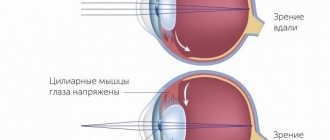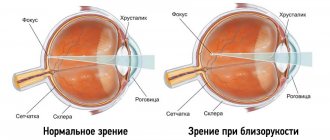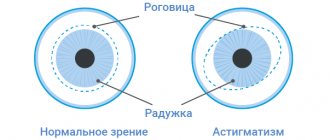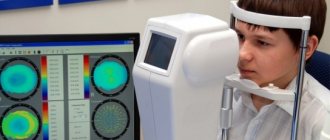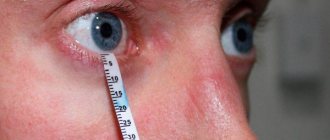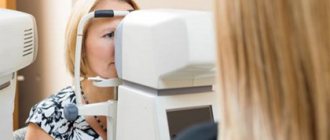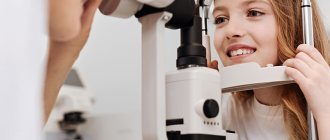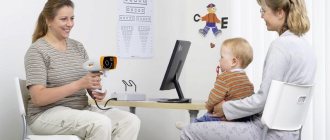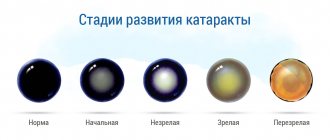Accommodation is a complex visual process during which a person sees objects equally clearly regardless of distance. For example, accommodation manifests itself when a person focuses first on distant objects, then on nearby ones.
When impaired, a person ceases to see clearly. Objects float in front of the eyes (either in the distance or near). The eye does not adjust to focus. Violation of accommodation significantly complicates a person’s life, as he ceases to see clearly. This causes great discomfort.
Causes of accommodation disturbance
Pathology can occur in people of any age. The occurrence of the disease, for the most part, depends on the lifestyle that a person leads. Therefore, it is recommended to follow the regime, lead a healthy lifestyle, and carefully monitor your health.
There are many reasons for the occurrence of pathology. This can be caused by any impact that negatively affects the visual system (the entire body as a whole).
“Natural” causes of the violation:
- improperly equipped workplace (the computer is located a short distance from the person, the furniture is not suitable for the age, a poorly lit place);
- long, intense work at the computer;
- spending a long time watching TV, telephone;
- painstaking work that requires increased attention;
- incorrect lifestyle (non-compliance with daily routine, unhealthy diet);
- lack or complete absence of sleep can lead to pathology;
- reduced immunity (insufficient amount of vitamins in the body);
- heredity (if there is a pathology in one (two) parents, the child is more likely to develop this disorder);
- aging of the body;
- stress.
There are causes from direct effects on the human body:
- injury to the visual apparatus (mechanical shock, burn);
- taking low-quality medications (there are some medications that temporarily reduce the performance of the accommodative system);
- recent infectious diseases (after which the visual system is most susceptible to pathology);
- presence of vascular diseases;
- unsuccessful eye surgery;
- poisoning with toxic substances.
There are a large number of reasons for the occurrence of violations. But with attentive and reverent attitude towards your eyes, violations can be avoided.
At-risk groups
The risk group is people who are susceptible to the appearance of pathology. These include:
- children of senior preschool age (the age when children learn to read and concentrate their vision on small things);
- school-age children (spend a lot of time with textbooks, TV, smartphones);
- office workers, programmers - people whose work is computer-related;
- people suffering from vascular diseases;
- people who have recently undergone surgery;
- people working with hazardous substances.
The risk group is recommended to visit an ophthalmologist 2-3 times a year without fail. Then possible complications can be avoided. Pathology will be detected in the early stages.
Classification of eye accommodation disorders
Doctors distinguish 6 types of pathology:
- Spasm of accommodation (false myopia). It occurs as a result of spasm of the ciliary muscle (the internal paired muscle of the eye). The eye focuses at close distances even when this is not required. As a result, a person practically does not see distant objects. Occurs more often in school-age children. It is important to identify a spasm of accommodation in the early stages. If this is not done, then false myopia will develop into real one.
- Weakness of accommodation. The disturbance of accommodation is incomplete. The eye focuses both at long distances and at short distances. But focusing with weakened accommodation takes some time. For example, if a person was looking into the distance and turned his gaze to a close object, this object will be blurry for some time. But after a short time it becomes clear.
- Habitually excessive tension of accommodation (PINA). Long-lasting tone of the ciliary muscle. Objects in the distance are blurry, but a person’s vision in both eyes is 1 (about 1). PINA of the eyes occurs when concentrating on objects that are at a distance closer than expected. For example, a person playing with a phone brings the device too close to their eyes.
- Paralysis (paresis) of accommodation. Occurs as a result of paralysis of the ciliary muscle. As a result, a person’s optical vision does not switch. Patients complain of the inability to read and write. The symptoms of paralysis are vivid, so patients consult a doctor in the early stages. Vision suddenly disappears. More often in both eyes at the same time (unilateral paralysis occurs less often).
- Accommodative asthenopia – increased eye fatigue (impaired refraction and accommodation). It is considered not a disease, but a borderline state before the onset of the disease. If accommodative asthenopia is not detected in time, a person may develop myopia (nearsightedness), hypermetropia (farsightedness), and astigmatism.
- Presbyopia is a natural physiological process. Presbyopia is not considered a disease. It is natural for the body to age. With age, changes occur in the organs of the eye (lens, cornea, eyeball), which can result in presbyopia. The pathology is called age-related farsightedness (a person sees poorly near, but sees objects located in the distance well). Occurs in people over 40 years of age.
Further treatment of the patient depends on the type of disorder.
Methods for studying accommodation
- Proximetry
- Determination of the volume of absolute accommodation
- Determination of the volume of relative accommodation
- Ergography
- Accomodometry
Accommodation (dynamic refraction) is the ability of a phakic eye to focus on the retina images of all objects in the external environment located in the space limited by its further and nearest points of clear vision. To study eye accommodation, predominantly subjective methods are used. Subjective methods for studying eye accommodation come down to finding the nearest point of clear vision and subsequent calculation of the volume of accommodation using the Donders formula.
Dynamic research methods involve bringing a test object closer to the eye until the image of the test object begins to blur or bifurcate (Shaner’s method), which corresponds to the closest point of clear vision. These methods include:
- determining the nearest point of clear vision using a Landolt cylinder, which has a number of small holes and a candle or light bulb burning inside;
- the Vannas method, in which the object is two parallel lines on a black background;
- reading small print, the angular size of which corresponds to the limit of visual acuity;
- Scheiner's method - viewing the tip of a needle or a point source of light through an opaque screen with two pin holes within the diameter of the pupil of the eye; the use of proximeters, which are a bar graduated in meters and diopters, with one or two supporting surfaces applied below the orbit of the eye, and with a test object moving along the bar using a slider.
Static methods - when using them, the test object is motionless, and the distance to it changes with the help of lenses inserted into the frame in front of the eye, first strong positive ones, then increasingly weaker positive ones and, finally, increasingly stronger negative ones. The advantage of static methods over dynamic ones is that the angular size of the test object remains unchanged. However, when changing lenses, the corner point may shift, which negatively affects the accuracy of measurements. The accuracy of measuring the volume of accommodation depends largely on the type of test. The test should be clearly visible to the nearest point and immediately become blurred after decreasing this distance. Test details can be recognized at a closer distance, so the distance to the nearest point is determined with some error.
Proximetry
A method for determining the position of the nearest and further points of clear vision. The simplest proximeter is a 50 cm long ruler along which a test object in the form of optotype No. 4 can be moved to check visual acuity from the near table. To determine the nearest point, place the object at a distance of 1-2 cm from the eye, after closing the second eye. The object is then moved away until the subject recognizes the optotype. This distance corresponds to the position of the nearest point. Since the further point is normally at infinity, they resort to optical simulation, or reduction. A collecting lens with a power of 3.0 D is placed in front of the eye, thus moving a further point to a distance of 0.33 m. Then the test object is gradually removed from the eye along the ruler. If the ruler is not enough, you can increase the power of the reducing lens. 3.0 D is added to the obtained value of the further point. For example, if the distance is 0.45 m, then the further point is determined by the formula: PR=-1/0.45+3.0=+0.75 D (refraction of points close to to the eye, it is customary to designate it with a “-” sign, since these points conditionally correspond to refraction for myopia).
Determination of the volume of absolute accommodation
The volume of absolute accommodation is the volume of accommodation of one eye when the other is turned off from the act of vision. To determine it, it is necessary to know the position of both points of clear vision. Instruments that can be used to immediately measure the nearest and further points in diopters are called optometers or accomodometers. In them, reducing lenses are introduced into the design. The subject looks into the lens of the device with one eye, and the researcher gradually moves the handle of the device, which, in turn, moves the test object inside it. The subject notes two situations: the appearance of a clear optotype and then its blurring. These will be the positions of the nearest and further points of clear vision. Their value in diopters is indicated on a scale, which is graduated from +6.0 to -5.0 D. The volume of accommodation is determined by the algebraic difference between two indicators on the scale.
Determination of the volume of relative accommodation
The volume of relative accommodation is the volume of accommodation with two eyes open in relation to a specific distance. The volume of relative accommodation takes into account convergence. Since the distance to the object is fixed (usually 0.33 m is used), it is necessary to apply lenses to the eyes - positive ones to relax accommodation and negative ones to strain it. You can use a spectacle frame for lenses, you can use a device to determine visual acuity, you can use an automatic or semi-automatic phoropter with a table mounted on its rod to check near visual acuity. Typically, text No. 4 is used as a test. The subject looks with both eyes at the text located at a given distance. Ametropia is first completely corrected. Sequentially positive and negative lenses are placed in front of both eyes in 0.5 D increments until the subject is able to read text. The strength of the maximum positive lens will indicate the negative (spent) part of the relative accommodation. The strength of the maximum negative lens will determine the positive part, or the reserve of accommodation. Its decrease indicates a deterioration in near visual performance, increasing visual fatigue and a predisposition to myopia or its progression.
Ergography
Refers to methods for objective assessment of accommodation. The essence of the method is to analyze the performance of the ciliary muscle of the eye under visual load at close range according to the perception of moving test objects. The results of the study are recorded in the form of a graphic record. Ergographic curves can be of several types. In the first type, the normal functioning of the ciliary muscle is stated. The remaining three types indicate an increasing decrease in accommodative ability.
Accomodometry
Objective accomodometry is a method that allows you to analyze the accommodative response of the eye to stimuli of various types and sizes. In this case, the main substrate of the analysis is the dynamic refraction of the eye and its instantaneous changes to the movement of a stimulus in space. Devices that allow you to objectively assess accommodation are called accomodometers and are fully automated. The frequency with which changes in refraction are recorded is from -2 to 10 Hz. The obtained data are presented in the form of accommodative response curves. Thus, it is possible to quickly present a stimulus of any magnitude within the area of accommodation (fast accommodative response) or its slow increase to a certain value corresponding to the volume of accommodation for a given subject, and then its gradual decrease (accommodative tracking). It is possible to hold the stimulus at the point of greatest tension of accommodation and examine the resistance of accommodation to tension. Finally, by assessing the dynamics of refraction with high frequency, it is possible to analyze the nature of visual fatigue. Objective accommodation is considered a method for qualitative assessment of accommodation.
Symptoms
The disease is characterized by a change in the shape of the lens. As a result of constant tension of the ciliary muscle, the lens acquires a flat shape and does not focus on distant objects.
Initial stage of violations
The initial stage of accommodation disturbance manifests itself with the following symptoms:
- rapid fatigue when concentrating the eye (performing small activities, working at the computer);
- headache;
- general discomfort – when the eyes are strained, it may sting and sting;
- the visible image becomes blurry;
- the eye has a hard time adjusting to changes in visibility (for example, if a person has recently looked into the distance, objects in front of him will continue to blur for some time);
- double vision;
- the occurrence of “dry” eye syndrome (the visual organ quickly dries out and gets tired).
Symptoms at the initial stage are clearly manifested, so the sick person can easily identify the disorder at the initial stage. If the above symptoms appear, it is recommended to consult a doctor immediately.
Age-related disturbances of accommodation
The visual organ ages along with the body. The components of the eye (lens, cornea, eyeball) gradually change. Because of this, a malfunction occurs in the visual system. A person may experience vision problems.
Age-related accommodation impairment manifests itself in patients over 40 years of age. People complain of blurred vision, inhibition of the accommodative system (long “switching” of the eye from near to distant objects and vice versa).
Forms of manifestations
Accommodation is characteristic of all mammals and consists of changes and deformations of the lens in the eyeball.
For example, in order to focus on a distant object, the lens must stretch out and become almost flat. But in order to focus on a relatively close object, the organ must, on the contrary, shrink and become “convex.”
The deformation of the lens is regulated by contractions and relaxations of the ciliary muscle, which is connected by ligaments to the lens and holds it in the desired position.
Thus, the work of the ciliary muscle consists of two synergistic processes:
- Contracts as the object approaches the eye;
- Relaxes as the object moves away from the eye.
The synergy of the ciliary muscle is manifested in the antagonism of the processes: relaxation is the opposite of contraction, and vice versa. The unity of these interrelated processes makes it possible to regulate the shape of the lens.
For example, accommodation manifests itself when a person alternately examines an object that is distant from him or that is close to him. To achieve the “minimum” and “maximum” tension of the ciliary muscle, it is necessary to wait until the vision is completely focused on the object.
Accommodation is carried out by the ciliary muscles, which, in turn, are affected by the oculomotor or oculomotor muscles. The ciliary muscle holds the lens with ligaments and, when it contracts, stretches it, giving it a more elongated shape.
Diagnostics
Detection of pathology begins with a visual examination of the patient. The ophthalmologist shows the eye's reaction to light, reveals visual acuity (using special tables). Next, an examination is carried out, which consists of the following procedures:
- Refractometry. Allows you to determine the ability of the eye to focus an image in front of the retina. The procedure is carried out using a special device - a refractometer. Takes 5-10 minutes.
- Skiascopy (shadow test). An ophthalmologist directs light rays to a person’s visual organ. The procedure allows you to determine the farthest point of clear vision of the patient.
- Biomicroscopy – examination of the fundus.
- Procedures are carried out to determine the reaction of the pupil to external changes. A number of procedures are aimed at determining the refraction of the patient’s eye (the ability to refract rays).
- In some cases, an ultrasound (ultrasound) examination is performed.
The examination is prescribed purely individually. For some patients, an external examination by an ophthalmologist and several procedures that are responsible for determining refraction are sufficient. Other patients undergo a complete examination.
When a pathology is identified, it may turn out that the reason for the appearance of the pathology belongs to another area of diseases (impaired accommodation can occur on a nervous basis). Therefore, sometimes ophthalmologists “refer” patients for consultation to the appropriate doctors.
Psychological theories and schools
Experimental psychology was founded in 1879 by Wilhelm Wundt. At the same time, such an approach to understanding human sensations, perception and psychology in general as structuralism prevailed.
Accommodation is a complex composite process in the psychology of structuralism, which is also part of visual perception. Structuralism was built on the study of basic “particles” that make up integral processes. Adherents of this approach argue that any whole consists of particles and atoms. Thus, the structuralists, represented by the students of Wilhelm Wundt and Bradford Titchener, outlined the structure of perception, and, as a consequence, its mechanisms.
Gestalt psychology arose as a reaction to the approach of Wundt and his followers and positioned perception as mutual influence both on each other and on the person, perceived objects and stimuli.
The principles of perception that Gestalt psychology has established include the following:
- Identification of figure and background.
- Differentiation.
- Closures
- Good shape.
- Isomorphism.
The constructivist approach is based on the fact that the individual is more responsible for shaping the surrounding reality than the actual physical characteristics of objects. The main role in the process of perception is given to the perceiver - that is, the observer, the subject.
From this, adherents of the constructivist approach established that perception goes beyond the formula “stimulus-response” or “exposure to stimulus-perception through the sensory organs.” Experimental confirmation of the theory was carried out by research by Irwin Rock, Julian Hochberg, Richard Gregory in 1988-1990.
An ecological approach to understanding perception was proposed by James Gibson in the mid-20th century. This theory, in contrast to the constructivist approach, makes the perceiver the object of perception. It turns out that, while exploring the surrounding reality, the perceiver only assimilates information without processing it.
However, Gibson also allocated a special place for the accommodation mechanism. From the point of view of the ecological approach, with increasing distance between the observer and any texture, it seems that its individual elements are reduced and form a solid, flat, smooth figure or surface.
Accommodation is, in the psychology of the information approach, the processing of information given by the environment in a specific form, similar to the program. It was founded, among others, by David Marra, who outlined the basic definitions in his monograph “Vision”. The environment here acts as a source of information, certain values of characteristics: shapes, outlines, lines, and so on. The function of consciousness becomes the processing of the received information, but taking into account only the illumination, like a computer program or a photo editor.
The neurophysiological approach determines perception, first of all, by the work of neural connections and impulses, the interaction of peripheral nerve centers with the brain. Francis Crick described perception from a neurophysiological perspective in 1994 in his book The Astonishing Hypothesis.
Cognitive neuroscience is an approach that studies thinking and perception as processes provided by the brain at the neural - that is, at the cellular - level. Each of the processes, for example, thinking, perception, attention or memory (higher mental functions) is determined by the work of different parts of the brain.
| Approach name | Representatives | Year | Main positions |
| Structuralism | Wilhelm Wundt, Edward Titchener | 1879 | Perception consists of individual processes and mechanisms. Accommodation is a mechanism consisting of individual interconnected processes. |
| Gestalt psychology | Max Wertheimer, Wolfgang Köhler, Kurt Koffka | 1912 | The main thing in the accommodation mechanism is the mutual influence of muscle contraction, light refraction and picture perception. If you change the flow of one component of the accommodation mechanism, then the final result of perception will change. Accommodation acts as a subprocess of perception and implements the principle of “figure and ground.” |
| Constructivist | Irwin Rock, Julian Hochberg, Richard Gregory | 1988 | The subject constructs the surrounding reality more than reality influences the subject. Accommodation is voluntary. |
| Ecological | James Gibson | 1947 | The individual perceives the surrounding reality as it is. In the process of perception, a person is a passive link. The accommodation mechanism is not arbitrary, it is regulated by lighting. |
| Informational | David Marra | 1982 | Reality is represented by a set of certain information. The brain processes it using certain computational operations. Accommodation is a genetically based involuntary mechanism. |
| Neurophysiological | Francis Crick | 1994 | Perception is determined by the functioning of neurons and physiology. Accommodation is an involuntary mechanism carried out with the help of the ciliary muscle and reflexes. |
| Cognitive Neuroscience | Bernard Baars, Gage Nicole | 1970-1990 | Perception is one of the cognitive functions of the brain, which is determined by the work of specific neural centers in the cerebral cortex. Accommodation is arbitrary and acts as a subprocess of isolating an object from the environment and orienting itself in space. |
Treatment
Treatment is determined individually. It is aimed at restoring the functions of the accommodation system. There are several types of therapy:
- medicinal (the patient is prescribed restorative drops, ointments that help relieve spasm of accommodation);
- vitamin complexes are added to the main drugs (they improve the functioning of the visual organ and encourage accommodation to restore functionality);
- physiotherapy (electrophoresis, magnetophoresis, magnetotherapy, massages);
- spectacle or lens correction (prescribed on a temporary or permanent basis, depending on the degree of pathology);
- laser correction (prescribed if accommodation disturbance is associated with damage to the eye organs).
Treatment is determined individually for each patient. When contacting in the early stages, the patient’s treatment is limited to medication and vitamin methods. In a short time, accommodation returns to normal.
Exercises to restore normal accommodation
It is recommended to do the following exercises at home:
- close your eyes (2-3 seconds) and open them;
- look from side to side (right-left, up-down);
- circular movements;
- changing the concentration of gaze: first on close objects, then on distant ones (or vice versa);
- massage the eyeballs with light circular movements (without pressure).
The exercises do not take much time, but help a person reduce the strain of eye accommodation.
Functions and role
The main function of the accommodation mechanism is to regulate the shape of the lens and thus change the incoming image from blurrier to clearer.
Accommodation is one of the most important mechanisms of visual perception in the psychology of perception. It allows you not only to examine individual distant or close objects, but also to distinguish between “figure” and “background” - that is, to isolate parts of a whole object.
Thus, accommodation allows a person to navigate the space around him. Thanks to this mechanism, a person has an idea of approaching objects, the position of the object in space, and the position in space of the perceiver himself.
Isolation of objects from the environment and concentration of attention are also accomplished with the participation of accommodation.
Thus, accommodation performs the following functions:
- Ensuring that objects are distinguished from the environment.
- Concentration of attention on certain objects and objects.
- Determining the texture of surrounding objects.
- Determination of the components of the structure of objects.
- Determining the position of objects relative to space.
- Identification of moving objects, fixation of a potential threat: fast movements, rapidly approaching objects.
The role of the accommodation mechanism in ensuring the holistic process of perception and orientation in space. In turn, impaired accommodation entails not only physiological inconveniences and physical stiffness, but also psychological consequences.
Thus, a person who is unable to identify objects of interest from the environment feels constrained and uncomfortable. This is the emotional background of an insecure person. If focusing pathologies are identified at a very early age, in infancy, or are congenital, this may be the cause of mental retardation.
As you know, vision provides the vast majority of information from the outside world. A person who is unable to focus attention on the constituent elements of the environment does not adapt well to changing conditions.
Prevention
To prevent accommodation disturbances, it is recommended to follow the following tips:
- eat right and follow a daily routine (sleep 7-8 hours a day, take walks in the air, eat more vegetables and fruits);
- 2 times a year take a course of vitamins for the eyes (Vitrum Vision, Complivit Oftalmo, Lutein-Intensive Evalar);
- undergo preventive examinations with an ophthalmologist 2-3 times a year;
- treat ophthalmic infections and inflammations in a timely manner;
- the workplace must be properly arranged (the computer is at a distance of 50 cm, the room must be well lit);
- perform eye gymnastics.
If you follow the above rules, the likelihood of pathology occurring will be significantly reduced.
